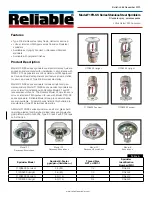
MA-K17510-KW LinerSCAN manual ISSUE P.doc
Page 81 of 93
4. Can I regress the engine hour on the air blast software?
Changing engine hours can result in data loss. It is not possible to regress the hours, but you can
export the data (archive to file) and create new files. See the ‘operation’ section.
5. Does the air blast cool the sensor?
The sensor uses coils manufactured from copper wire. This copper wire has a resistance that changes
as the temperature changes. The sensor coil has two such coils; one which is a reference coil located
in one half of the instrument, and the other is the measurement coil into which the sample flows. When
the instrument has been on for some time the temperatures of these two coils are the same. This has
the effect of cancelling out any changes in ambient temperature. If a warm/cold sample is introduced
to the sensor, the measurement coil is warmed and this unbalances the two coils, causing a small shift
in readings of 10ppm. The sensor bore can be cooled by extended blasts of cold air through the
sensor. Air blasts <10 seconds should solve this issue. Blast <2 seconds are not recommended due to
the risk of blockages.
6. The output from the sensor sometimes varies with temperature?
The sensor uses coils manufactured from copper wire. This copper wire has a resistance that changes
as the temperature changes. The sensor coil has two such coils; one which is a reference coil located
in one half of the instrument, and the other is the measurement coil into which the sample flows. When
the instrument has been on for some time the temperatures of these two coils are the same. This has
the effect of cancelling out any changes in ambient temperature. However imbalances in coil
temperature – which are typically caused by fluid flowing through the sensor and altering the
measurement coil temperature more than the reference coil temperature. This can cause a
temperature induced variance of 5ppm per 10°C [18°F].
7. Why does the sensor output 25ppm with no oil in the sensor measurement chamber?
The sensing coil is designed to detect metallic particles. However, nearly all materials can be
magnetized when placed in a magnetic field; oil and to a far less degree air.
Therefore materials inside the coil of the sensor experience this magnetization, and influence the coil
and hence sensor output. These influences are very small, approximately 10ppm (0.001%). The
sensor is corrected for the effect of oil, which equates to -25ppm.
Consequently, when oil is removed the +25ppm offset applied to the sensor output is observed.
8. How can Pipework blockages be Prevented?
The air-blast technique ensures that the pipe-work will not become blocked. It is imperative that power
and air supply to the sensors is not interrupted.
The period between measurements needs to be at least every 30 minutes.
If sensors are to be turned off for more than 12 hours before they are allowed to blast, close all
isolating valves. If the valves are closed for long periods check that there is no blockage just behind
the valve (Engine side).
Summary of Contents for FG-K17401-KW
Page 9: ...MA K17510 KW LinerSCAN manual ISSUE P doc Page 8 of 93 3 Installation Installation ...
Page 34: ...MA K17510 KW LinerSCAN manual ISSUE P doc Page 33 of 93 4 Commissioning Commissioning ...
Page 40: ...MA K17510 KW LinerSCAN manual ISSUE P doc Page 39 of 93 5 Operation Operation Manual ...
Page 89: ...MA K17510 KW LinerSCAN manual ISSUE P doc Page 88 of 93 ...














































